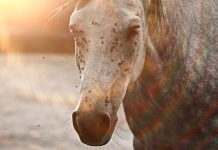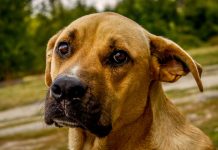The Neapolitan Mastiff, or Napoletano Mastino, is a service dog that can become an excellent bodyguard and protector of property. The distant ancestors of these dogs are the Roman Molossian Great Danes. According to one version, Napoletano Mastiff appeared about two thousand years ago. During this time, they managed to establish themselves as excellent guards, work as partner police officers, and play the role of accomplices of the intruders. In addition, at all times, the Neapolitan Mastiffs were pets, dogs that bring joy to the family.
Despite their formidable appearance, these dogs have a docile disposition. They are level-headed, non-aggressive, and friendly. By its nature, Neapolitan Mastiff remains a child until old age – gentle, loving attention, games, and affection. He is sociable and gets along great with children. Nevertheless, the Neapolitan mastiffs choose one master from the family members, to whom they remain obedient and infinitely loyal. In the absence of the owner, the dog is very bored and really suffers during a long separation.
Brief Information

- Breed name: Neapolitan Mastiff
- Country of origin: Italy
- Breed origin: 1949
- Type: Molossus
- Weight: 60 – 70 kg
- Height (height at the withers): 60 – 75 cm
- Life span: 10 – 12 years
History

The Neapolitan Mastiff belongs to the Molossian group, one of the most ancient and widespread. However, there is a lot of controversy about the history and origin of these dogs. What is known for sure – Molossians were spread throughout the Roman Empire by the Romans themselves and the European tribes captured by them.
There are dozens of theories about the origin of Molossians, but they can be divided into five main groups of origin: from Central Asia, Greece, Britain, the Middle East, and from the dogs of the Alan tribe.
Molossians were widely used by the Romans. They guarded livestock and property, were hunters and gladiators, war dogs. They were mentioned by Aristotle and Aristophanes, they terrified the tribes of Franks, Goths, and Britons.
After the fall of the Roman Empire, they did not disappear but were firmly rooted throughout Italy. During the Middle Ages and the Renaissance, they served as guard dogs, prized for their protective nature and ferocity.
Despite their long history, they were not a breed in the modern sense of the word. In different countries, mastiffs had to interbreed with different local breeds and as a result, modern dogs were obtained.
In Italy, some lines were workers, others were sentries. From the workers came the breed that we know as the Cane Corso, from the watchmen the Neapolitan Mastiff, although this name appeared in the 20th century, and the lines themselves constantly crossed.
Popular with the upper class, the Neapolitan Mastiff was however not a common breed. Plus the desire to get as big dogs as possible led to heavy inbreeding.
Sentinel Mastiffs served the upper class of Italy for centuries, thieves and robbers of all stripes could not resist these giants. They were gentle with their own and merciless with their enemies. Dogs from the southern part of the country, near the city of Naples, were especially appreciated. They said that they were not only fierce and fearless but also disgustingly ugly.
Their appearance so shocked strangers that they were in a hurry to get out in a good, healthy way, forgetting about everything. Southern Italy remained a stronghold of the aristocracy, while other parts of the country had republics and free cities. It was the aristocracy who could keep and breed these large dogs, but social changes took place at the beginning of the 20th century.
The aristocracy has significantly weakened and, most importantly, it has become impoverished. Keeping such dogs was already difficult, but they managed to practically not change until the beginning of the First World War, despite the fact that there were no breed standards, clubs, and shows.
Lucky Mastino and the fact that the First World War was held in Northern Italy, almost without affecting them. But the Second World War took place across the country, significantly reducing the already small population of dogs.
Military actions, devastation, famine did not contribute to the growth of the population, but nevertheless, the Mastino Napoletano suffered from them to a lesser extent, compared to other European breeds.
They had their fans who did not give up breeding even in the days of the war. One of these people was Dr. Piero Scanziani, who created the breeding program, the breed standard, and thanks to him it was recognized throughout the world.
Since dogs have long been associated with the city of Naples, they decided to call the breed the Neapolitan Mastiff or Napoletano Mastino in their native language.
The breed was first presented at a dog show in 1946, and in 1948 Piero Scanziani wrote the first breed standard. The very next year she was recognized by the Federation Cynologique Internationale (FCI).
Until the middle of the 20th century, the Neapolitan Mastiffs remained an indigenous breed practically unknown outside of Italy. However, since the late 1970s, individual individuals have entered Eastern Europe and the United States. The breeders were amazed at their size, strength, and unique appearance.
However, the size and character of the dog limited the number of people who could keep it and it remained rare. In 1996, the breed was recognized by the United Kennel Club (UKC), and the American Kennel Club (AKC) only in 2004.
Despite its growing popularity, Napoletano Mastino remains a rare breed. So, in 2010 they ranked 113th out of 167, according to the number of dogs registered in the AKC. Most of them are used as companion dogs, but they also carry a guard service.
Their temperaments have softened over the past decades, but they are still excellent guard dogs, with the most powerful qualities of any mastiff.
Species, Standards, and Varieties

The Neapolitan Mastiff is characterized by a rough physique. He has a straight back and a large chest. Its girth is almost a quarter higher than the height of the dog at the withers. The growth of a Mastiff ranges from 60-68 cm in bitches and 65-75 cm in males. It is almost 10% less than the oblique length of the body. The weight of the animal can be from 50 to 70 kg.
The tail, with a wide base, tapers slightly at the tip. It can be docked up to 2/3 of its length. When the animal moves, the tail is slightly raised above the dorsal line. At rest, it is omitted.
Neapolitan Mastiff has a massive head, the length of which reaches 3/10 of the height of the dog at the withers. The line of the upper part of the skull is parallel to the surface of the muzzle. On the head of the animal, as well as on the whole body, there are deep folds. The largest one stretches from the outer edge of the eyelids to the corner of the lips. The sides of the head are practically parallel to each other. Therefore, when viewed from the front, the dog’s muzzle looks square.
The short neck has a frusto-conical shape. At its base, the skin forms a double dewlap. The ends of the fold are under the jaw joints. The fleshy lips are connected in front at an acute angle. The dog has powerful white teeth. The upper incisors cover the lower ones or join with them when the jaw is closed.
A large nose does not protrude beyond the lip line. The Neapolitan Mastiff looks straight ahead. His rounded eyes are slightly deepened. The color of the iris depends on the color of the animals. It is usually slightly darker than the shade of the shirt. Small ears are lost against the background of a massive body and a large head. They are attached to the cheekbones.
Neapolitan Mastiff has strong, muscular legs with strong bones. The hind feet are slightly smaller than the front ones. The pads on the paws are hard, dry, painted black. Curved claws are very strong. The dog’s gait is measured, a little lazy. His movements resemble those of a lion. During the run, the animal is sharply repelled by its hind legs and sweepingly throws out its front limbs.
The Neapolitan Mastiff is covered with a smooth and shiny coat. Its length does not exceed 1.5 cm. The giant’s hair is coarse and coarse. Coat colors can be gray, lead-gray, black, brown, and red. Some animals are dark red (chestnut with dark guard hair tips) or brindle. Individuals of tiger coloration can have gray, black, and red tones on the body. The breed standard allows the presence of pale yellow (isabella), gray-gray and nutty shades. Dogs have small white patches on their chest and toes.
Personality

Neapolitan Mastiffs have been guard dogs and bodyguards since ancient Rome. It is difficult to expect from them the character of a herding dog. They are usually calm and confident in themselves, but in case of danger, they can turn into a fearless protector in the blink of an eye.
They love their masters and are surprisingly gentle with those they trust. Puppies are gullible and sociable at first but grow into more closed dogs. Distrustful of strangers, definitely not the ones who greet anyone they meet.
Socialization is critical to the Neapolitan Mastiff. Those who have not been socialized grow into aggressive dogs that bite more often than others.
And their strength and size make bites a very serious matter. But remember that even perfect socialization cannot smooth over millennial instinct.
Even the most trained Mastiffs will attack strangers if they invade their territory during the absence of the owners’ home.
They can be kept in families with children, however, most experts do not recommend doing this. These massive dogs can hurt a child even while playing. In addition, noisy and whiny games of children are aggression for them and they can react accordingly.
It is not a good idea to keep them with other dogs. Most Neapolitan Mastiffs do not tolerate dogs of the same sex, and some of the opposite. Some get along with the dogs they grew up with, but others can’t stand them either.
It is extremely difficult to reconcile them with adult dogs, especially since the most striking feature of the breed is jealousy. They are very jealous and show their jealousy through aggression. Any tension between a mastiff and another dog will end sadly. After all, there are not so many breeds capable of resisting a fight with them.
They can be taught to cats and other animals since they do not have a pronounced hunting instinct. However, it is necessary to train them as early as possible, as the guard instinct forces them to view other people’s animals as a threat. They will definitely pursue strangers on their territory, remember that even if they love a domestic cat, then this love does not apply to the neighbor.
Neapolitan Mastiffs are very smart and understand commands well, they can be obedient in the hands of someone they respect. A calm, confident, and the experienced owner will be satisfied with the training process and result. This dog does something not because it was ordered, but because it respects the owner. And this respect must be earned.
They are dominant and able to put a person below themselves in the hierarchy of the pack if allowed. The owner should regularly remind the dog who is who and put it in place. If the Neapolitan Mastiff believes that he is an alpha, he will be willful and out of control. The General Obedience Course is highly recommended for this breed.
If they are not at work, then they are surprisingly calm and relaxed, lying on the couch and not thinking about additional loads. They would prefer not to move once again, but they still need regular, moderate exercise. If they do not receive one, they may get bored.
A bored mastiff is a destructive, aggressive mastiff. But, activity and exertion should be moderate, especially in Neapolitan Mastiff puppies.
Education and Training

Of course, Neapolitan Mastiffs are kind and calm dogs, but this does not mean that they do not need training. On the contrary, if such a large and strong dog grows up uncontrollable, you simply cannot cope with him: he will pull you where he wants and can scare someone with his appearance, just by going to meet. And fear, as you know, has large eyes, and a frightened person can declare that your dog attacked him.
To avoid such incidents, it is necessary to raise the puppy from a very early age.
It is worth remembering that Neapolitan Mastiffs tend to dominate, so in adolescence, they will definitely try to impose their will on you, and it depends on you whether your character is stronger. But in no case should you resort to violence and lose your temper – this will only embitter your dog, and a ferocious mastiff can pose a real threat. Remember that a dog is angry only through the fault of the owner.
Maintenance and Care

The large dimensions of the Neapolitan Mastiff suggest keeping in-country or private houses, but often these dogs live in apartments. In any case, the dog should have its own place, quite free. It is desirable that the litter is of medium hardness – too soft will allow the bones to deform, and hard and hard will leave ugly bald patches on the short coat. It is required to equip the dog’s place with bowls for water and food, toys (while their size should correspond to the largemouth of the mastiff in order to avoid swallowing). If the dog lives in an apartment, then walking is necessary, at least 2 times a day. At the same time, mastiffs, as a rule, are not lovers of excessive physical activity, therefore, calm walks in the fresh air and the dog will benefit, and the owner will not be exhausted. By the way, mastiffs do not like excessive summer heat, and they adore sleeping in the fresh air.
By and large, the Neapolitan Mastiffs do not bring much trouble to their owners, which is due to the presence of their short hair. To improve blood circulation, cleanse the coat and remove dead hairs, it is recommended to comb out Neapolitan Mastiff at least 1-2 times a week (more often during molting). Since this breed has a large number of skin folds, improper care and lack of hygiene can lead to irritation and infection. The area around the eyes of the dog should be clean, without pathological discharge (already drooping eyelids can be seriously inflamed). But you should not wash your dog often, it is recommended to regularly view the folds (after eating, walking), wipe them, cleaning them from dirt, saliva, food debris. After a walk, it is advisable to wash the dog’s paws, and full bathing with water and shampoo should be performed no more than 3-4 times a year (or in cases where the animal is excessively dirty).
The characteristic physiological features of these dogs have increased salivation, heavy breathing, and snorting, which can sometimes be a difficult factor for these giants to live in a small city apartment. Sometimes the owners of Neapolitan Mastiffs make the mistake of thinking that the large size of these animals implies an excessive appetite. Overfeeding often makes already massive mastiffs obese. Only a bowl of clean water should be left to the dog at all times, while the bowl of food should be exposed to the dog and removed after 15-20 minutes (and then washed).
Health

The main diseases that lie in wait for mastiffs are: dysplasia of the joints (which is fraught with osteoarthritis), cardiomyopathy (which can be a consequence of congenital heart diseases and also be caused by various infectious and bacterial diseases, etc., develops in many large, and especially elderly dogs), skin infections (caused by mites – demodicosis, staphylococci – pyoderma, trauma, allergies, fleas – dermatitis, as well as other diseases). As you can see, such diseases are “fair” due to the size of the dog, its enormous number of skin folds, and its high weight. From early childhood, the Neapolitan baby should be shown to a doctor for examination. It is necessary to carry out timely prevention of internal and external parasites, as well as vaccination as prescribed by a doctor. Monitor the correct nutrition of the dog and the good condition of its eyes, coat, and skin. With proper care and respect, mastiffs live for about 10-12 years.
How to Choose a Puppy

Puppies are best purchased from a nursery. Professional breeders carefully select parents for future babies. A dog with a good pedigree will not only have a great conformation, but also a manageable character. When purchasing such a large dog, you need to be sure that he does not have aggression.
Since some kennels do not cull animals with dysplasia, it is necessary to exclude this hereditary disease in the puppy. In dogs with dysplasia, the croup is sloping and the back has a characteristic deflection. The hind legs are close to the front and tense. Their position looks unnatural.
Neapolitan Mastiff puppies are miniature copies of adults. If you don’t like something about the baby’s exterior, you need to refuse to purchase. When the dog grows up, the flaws will not disappear. It is necessary to take a closer look not only at the puppy but also at its parents. Children are highly likely to inherit all of their qualities.
When buying babies over 2 months old, you may need the help of a specialist. Not all young Neapolitan Mastiffs develop uniformly. A puppy can grow different body parts at different rates. A kid who looked tall a week ago may look like a dachshund. And after another week, his body will acquire the correct shape, but the head will become too small.
A thoroughbred puppy is distinguished by its “muzzle”. The width of his muzzle should be slightly less than the width of his head. The muzzle should be shorter than half the length of the skull. If the baby’s muzzle is elongated and looks like a cone, it is better to refuse it. The sign of the breed is the “lily” on the head. If the puppy has a straight fold, it will not get the shape it needs over time.































